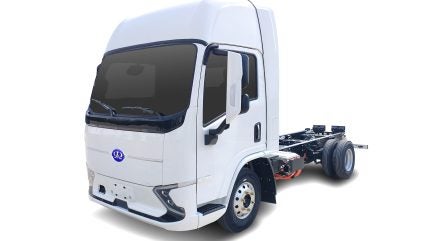
Mobility and transportation are undergoing continuous shifts as technology advances and sustainability policies evolve. However, one sector which is moving at a slower pace is the trucking industry. Alternatives to diesel power will take time to present a credible alternative.
North America’s newest electric commercial vehicle brand, ZM Trucks, leverages Japanese designs to produce purpose-built, zero-emission commercial vehicles or ‘work trucks’ for the urban environment. Designed in Asia, sourced from a global supply chain, and assembled near their sales regions, ZM Trucks in the US describes itself as the Western expression of the brand.

Discover B2B Marketing That Performs
Combine business intelligence and editorial excellence to reach engaged professionals across 36 leading media platforms.
The company claims it has achieved price parity with comparable diesel trucks, paving the way for commercial vehicle fleet operators to seamlessly transition from diesel to zero-emissions without compromise.
We spoke with Joost de Vries, CEO, ZM Trucks, to learn more about the benefits of alternative fuel trucks, and to discuss their potential future.

Just Auto (JA): Could you provide me with some background on the company?
Joost de Vries (JV): We were born in Japan several years ago, working on bringing fully electrified Kei cars into the Japanese market. Over the years this has grown into more or less a full product portfolio of working trucks. We started exporting and building those for Asia and then we saw opportunities in Africa, Middle East, South America, and one of the last markets we’re going into now is North America.
What types of trucks does the company produce?
The type of trucks we deal with in workshops are not tractors for the long-haul freight trailer. We’re not into long-distance, because battery technology is simply not suitable for that yet, but we are in work trucks and what we call back-to-basics trucks.
We specialise in five tonne up to 22 tonne [GVW] work trucks, that allow for a dump truck or refuse truck application. You can use electric power now for almost all functions in what we term work trucks, and that is what we’re concentrating on.
What are the benefits of alternative fuel over traditional diesel fuelled trucks?
It’s very difficult to move fourth-generation diesel drivers into anything else other than a diesel powered unit. The number one challenge we have is simply cost per mile.
It’s not about the acquisition cost of the truck; it’s really about the total cost of ownership (TCO), so that includes all cost elements – maintenance, tyre wear, acquisition costs, leasing residual value, and then on top of that, of course, the actual cost to move the truck.
It’s very difficult to move fourth-generation diesel drivers into anything else other than a diesel powered unit.
If you look at alternative powertrain choices, you have batteries that work well for short distances, back-to-base in urban environments. The batteries are very heavy and very expensive, of course, so once you get into long distances, they simply don’t make sense.
For those areas, you really need to look at a fuel cell, or what they now call hydrogen ICE. So, that’s hydrogen that can be used like diesel fuel in a traditional combustion engine, and I think the long-distance high-power use cases are really moving towards hydrogen ICE. Europe is very much in the forefront, as is Japan.
Fuel cells also have this really nice little middle niche – low power, good range. Then for the shorter distances, light and medium duty, batteries can certainly play a part as new energy solutions.
What is the company plan for moving into North America?
We are launching at the Advanced Clean Transportation (ACT) Expo in Las Vegas, and ACT is really the global marketplace where everybody comes together and showcases new transportation solutions. It’s the right forum and the right platform for us.
It it’s very scary on one end because we are a brand new 22-year-old brand coming into a market that is, at the very least, highly suspicious of the case for making a major change.
There’s also an aspect of people perceiving a government push behind this, rather than it being demand-pull or owner-requested. That is why we have to be very clear when we come up with our brand and say it’s about the total cost of ownership. There’s no way that we can beat every use-case scenario, but in certain duty cycles we’re going to be awesome. We can prove to the fourth-generation diesel driver that we can make their life better and cheaper, and that’s really what we need to concentrate on.
What do you see the future holding for the truck sector?
The government has certain adoption rate curves that they state need to be achieved. A single word answer to that is: Disneyland. It’s never going to happen.
Is there going to be a curve of adoption? Yes, for sure, and I think all OEMs are committed to that. The decision is passed that we’re on a road towards zero emissions or much lower emission solutions. But is the adoption rate going to be as fast as the government envisages? Absolutely not. The grid cannot even handle it.
If you want to have a fast charger installed in your parking lot in California, there’s a three year wait just to get the charger installed. We have to be realistic.
I think an incredible accelerator for the adoption rate is going to be hydrogen.
I think an incredible accelerator for the adoption rate is going to be hydrogen. It is relatively simple with mobile hydrogen fuelling stations to get a hydrogen highway for people to fill up quickly, so much easier than the grid.
It depends a little bit on the choices of the government. If it is hell-bent on batteries, it’s going to take a long time. If there are more choices open to zero emissions like hydrogen, especially hydrogen ICE as you fuel, I think you’ll see adoption rates go dramatically faster.
What would you say to someone who is maybe hesitant on trying these new truck solutions?
Don’t be afraid. I think that is the biggest thing – I know it’s scary, because it’s so different. You need to think about charging rather than just fuelling up in six minutes at a gas station.
Don’t go all in, just try it. If you run ten trucks, take one truck. Don’t even buy it – lease it! Take short-term pain to educate yourself; the long-term benefits will become apparent if you have the right partner that you can deal with. Don’t be afraid. Those are my words of wisdom, as somebody who’s been in diesel for 14 years!






